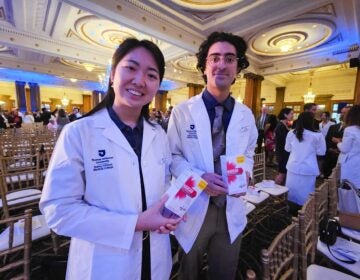Woodmere director’s favorites tour a hit with patrons
Woodmere Art Museum Director Dr. William Valerio had hoped to lead a small group on a tour of his favorite works in Woodmere’s galleries and archives last weekend, but an unexpectedly large crowd –upwards of fifty people – on such a warm and sunny St. Patrick’s Day necessitated a change of plan.
Instead of a mobile tour of the museum, Valerio gave a presentation more suited to a crowd, setting up seating, a projector screen and a few notable paintings in Woodmere’s Catherine Kuch rotunda. Through the lens of some of Woodmere’s most treasured works and surrounded by the paintings of the current retrospective on Elaine Kurtz, attendees got a charming lesson on Woodmere’s past, as well as a sneak peek into its upcoming exhibitions and expansions.
How we got the Woodmere
Valerio began with a slide of the man who first envisioned Woodmere, the Philadelphia-born businessman and noted arts patron Charles Knox Smith (born 1845), who purchased the original Woodmere property and Victorian mansion in 1890. Displaying a turn-of-the-century image of Smith by noted Philadelphia portraitist Albert Rosenthal, Valerio speculated on how the two men met – perhaps through Rosenthal’s work painting Philadelphia’s mayors between 1890 and 1915? (Some of these portraits can still be seen at City Hall today).
Smith purchased Woodmere and lived there with his wife until his death in 1916, but he had a clear vision for the house’s future. In his will, Smith stipulated that his house and all the art he’d collected in it (over 2,000 pieces) “shall be converted into a public museum and gallery…for the use and benefit of the community in which I have lived.” His wife, who preferred a solitary life, continued to use the property as her private residence until her death.
In 1940, the museum’s future began in earnest, with its first Director, Edith Emerson.
At the time, her position was an unusual one for a woman, and proved a boon for some of Philadelphia’s notable mid-20th-century artists, many of whose work might not have otherwise been selected for galleries because of the artists’ sex. As Valerio illustrated, many female artists “weren’t taken seriously” at the time, but Emerson saw them as equals to the male artists of the day.
Violet Oakley and Edith Emerson
One artist whose legacy is bound up with Woodmere is muralist Violet Oakley, Edith Emerson’s partner, whose most notable work includes the murals at the Pennsylvania State Capitol. Woodmere holds a number of Oakley paintings and murals.
Valerio’s Saturday presentation went on to show a painting by Emerson, herself an artist, depicting Oakley in her dining room. Striking in its colorful symmetry, the work’s composition gives an arresting awareness of the painter’s unseen presence and her connection to Oakley.
Arthur Carles
Emerson’s legacy was not all peace and joy – Valerio showcased a painting by another artist, who, by all accounts, had a tempestuous relationship with Emerson. Arthur Carles (1882-1952), a student of the Pennsylvania Academy of Fine Arts in the first decade of the 20th century, was instrumental in the birth of modernism in American art. An admirer of Matisse and Cézanne, after a long Parisian pilgrimage, he brought their techniques to Philadelphia and himself became a major influence on a generation of American painters.
Valerio showcased a Carles portrait from the 1920’s, recently added to Woodmere’s collection, of a woman with a mane of red hair. On second glance, her seemingly marble-white skin is a riot of expertly sculpted purples, blues and greens. But despite Carles’ excellent mentorship of several female artists, including Betty Hubbard, whose Carles-influenced work Valerio also displayed, Emerson viewed him as an unsavory character: according to Valerio, an alcoholic and an aggressive womanizer. She refused to buy or display any of his work.
Given Carles’ importance to the American art scene, and his evident care for the painters he trained, Valerio is moving to heal the breach by bringing Carles’ work to Woodmere.
Benjamin West
Among many other 19th and 20th century artists displayed on Saturday, Valerio gave special attention to an 1806 masterpiece by the famous Benjamin West: a “world class” painting that Valerio posited the Louvre would be “happy to have”.
Its scene is unique for a war epic. The main subject of the painting, Sir Philip Sidney, a poet and luminary of the court of Queen Elizabeth I, is shown following a skirmish between Spanish and English troops in the Netherlands, where Sidney was appointed a governor. During the battle, his thigh was shattered by a musket ball, and the wound proved fatal. He was in his early thirties. In West’s painting, while anxious soldiers tend his wound and attempt to serve him water, Sidney refuses the water and gestures expansively to another wounded man, urging the soldiers to attend him instead.
Valerio pointed out that the painting is also notable because it may contain the only known self-portrait of West, who is shown in a reverent pose at the far right. “This is a wonderful history painting because of the way the artist tells a story,” Valerio said. Conjuring up a different world for art lovers, he urged attendees to imagine viewing large-scale paintings like this in the age before modern entertainment.
“People might examine the nuances of a painting for an hour,” he said.
A question-and-answer session followed, in which Valerio addressed queries about displays versus archives, artwork preservation, and the selection of works for Woodmere. Finally, guests enjoyed a wine and cheese reception.
Upcoming at Woodmere is an exhibition Valerio described as “realism gone crazy” as he gave patrons a preview of a few of the paintings to be displayed. As for Woodmere’s future shows and expansions, Valerio shared hopes for a gallery dedicated to Carles and his students, a greater emphasis on African-American artists, and a permanent Violet Oakley exhibition.
WHYY is your source for fact-based, in-depth journalism and information. As a nonprofit organization, we rely on financial support from readers like you. Please give today.








